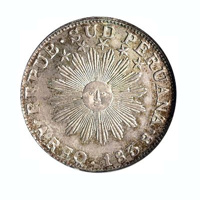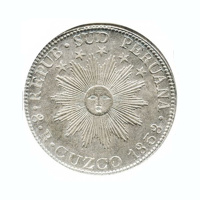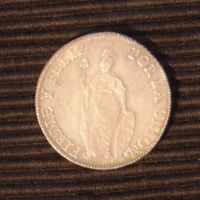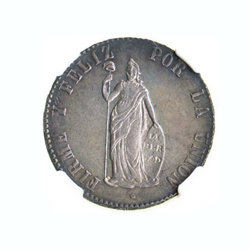Colonial Peru 1568 - 1826
The mint of Lima was the first South American mint and began striking coins in 1568. The 1st Assayer:
Alonso de Rincon struck all silver denominations (1/4 - 8 reales) from 1568 - 1570. Colonial coinage
concluded for almost all denominations in 1824, however, some 2 reales were struck in 1826 before the final
Spanish surrender on Jan 22nd, 1826.
|
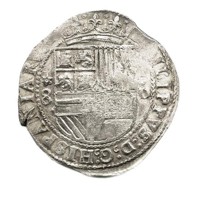
Spanish King Philip II
8 Reales ca 1580's LIMA mint
(uncirculated)
(Sedwick Auction 9, 27-Apr 2011, lot# ??)
|
Lima, Peru, cob 8 reales, Philip II, assayer Diego de la Torre, *-8 to left,
P-oD to right. S-L4; KM-14; CT-148. 27.3 grams. Lustrous UNC (very rare grade for a cob),
with choice full crown, full but partially weak shield and cross (uneven thickness),
much legend, light tan sediment and toning in crevices, broad flan
Auctioneer's description
|
Philip IIKnown as Felipe el Prudente
(Philip the Prudent), he was born in 1527 and reigned 1556 - 1598.
Quite well known for his repeated attempts to invade England, it seems to me that he
was not particularly prudent. Also he was apparently quite persistent in his attraction
for Elizabeth I, Queen of England.
|

Spanish King Charles III
8 Reales 1779-PTS mint
NGC ms-64 (uncirculated)
(Sedwick possibly Auction 25, 3-May 2019, |
|
Charles III, b. 1716, reigned 1759 - 1788. This was
actually a prudent King who fostered the Enlightenment in Spain. He also increased revenue to
the crown and made a number of reforms. |

Spanish King Charles III
8 Reales 1782, Lima mint
NGC ms-63 (uncirculated)
(Sedwick Auction 25, 3-May 2019, lot# 1265) |
|
Charles III |
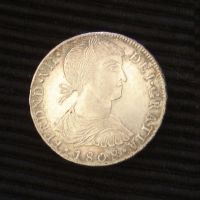
Spanish King Ferdinand VII
8R, 1808, almost uncirculated
(Stack's)
|
Charles-IV abdicated in favor of his son Ferdinand VII in 1808. Normally a transitional portrait
would be used on the coinage: e.g. the portrait of the old King but with the titles of the new King,
at least until the countries could discover what the new King looked like. See the
Mexico_1R_1809 for an example.
The Regency of Peru, however, decided to place a fanatsy portrait of what appears to me to be a Peruvian Indian on their
coinage with the title of Ferdinand VII. A different Peruvian Indian was used in 1809 & 1810. |
|

Spanish King Ferdinand VII
8 Reales 1815 Lima
brilliant uncirculated
Sedwick Auction 11 11 Apr 2012, lot 1335
|
Sold as "lusterous unc" before slabbing of foreign coins became common.
Possibly an ms-63 or better today. Sold for $220.
|
|
Independent Peru
|
|
Peru has a very diverse numismatic legacy. Possessing silver mines it was re-invaded by
the Spanish after proclaiming independence and striking it's own coins. Early coinage, although beautiful (1826-28 series),
was simplistic: inviting counterfeiting. During 1836-39 Peru was part of the Peruvian-Bolivian Confederation. This permitted
an infestation of low-silver content Bolivian coinage (moneda feble)
to drive out all the good currency in Peru. Peru's southern mints were also attacked during wars depriving them of specie from which to make coinage.
Numismatically collectors avoid the coinage of Republican Peru. One prominant dealer told me that it's only collected as an adjunct by Colonial Collectors as "post-colonial pieces". Another guess is that during major auctions, Peru comes up alphabetically at the end of the auction; often past midnight. Since I'm a night owl anyway, I've gotten more than my share of neat coinage.
This hasn't discouraged the 8 reale cobs of 1568 - 1569 bringing very good prices. These were historically the 1st 8 reals struck in the New World until the discovery of more of the 1538 Mexican 8 reales.
|
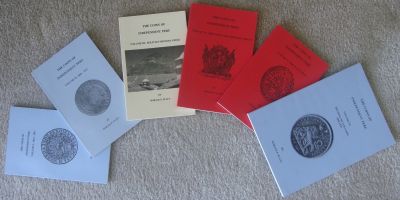
To learn more here are a set of books: "The Coins of Independent Peru" by Horace P. Flatt, vols 1-6
|
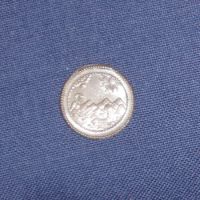
1/8 Real 1823 restrike
uncirculated
(Karl Stephens, ca. Nov. 2004)
|
This copper coin (the size of a current US 1 cent) was officially restruck by
the Peruvian Government on 1921 using original dies to celebrate the century of
Independence.
|
|
col1
|
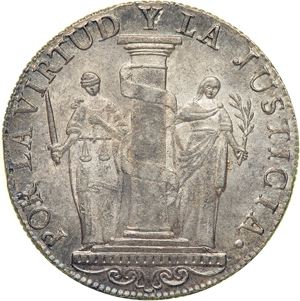 8 Reals 1822
(photo from Goldberg's Auctions)
8 Reals 1822
(photo from Goldberg's Auctions) |
This is the first type of Peruvian Republican coin, issued in 1822 & 1823 and is known as The Peso of San Martin.
The link to Goldberg's "Milennia Collection" which featured a number of amazing Peruvian {& other Latin American} coins is here. Millennia Auction
Note that the Goldberg's page is http and not https, so you may get a security warning.
|
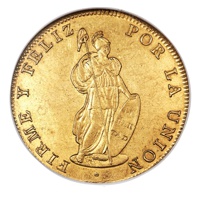 8 Escudos 1826 Cuzco mint,
8 Escudos 1826 Cuzco mint,
uncirculated, NGC-62
Eliasberg, April 18-19, 2005, lot 3528
Heritage, Aug 3rd 2017, lot 30424
photo by Heritage |
The 1st gold 8 escudos or onzo of Independent Peru Finest known specimen.
I actually looked at this piece in person back at the Eliasberg sale in NY in '05'. I didn't get it
as I was too inexperienced in Latin America at the time.
Then when I saw it at Heritage in 2017 I was able to buy it.
No hairlines, no friction {wear}, however the planchlet
on the reverse is a little rough as made. No laminations.
Listing of this coin at Wiki Coin Facts with photo. Well, it USED to be here...
|
Peruvian mint records are very sketchy around this time period and we don't have the actual number struck. According to a Peruvian specialist, Peru's 1st gold coins were the Lima 1826 half and one escudos. Lima had issued Standing Athene silver coins since 1825, and based on investigations made by Horace Flatt, Cuzco had the dies ready by September, 1826. Thus the
Cuzco gold coins were struck from Sept. 1826 or thereafter.
--thanks to victor for information on the early coinage of peru.
|
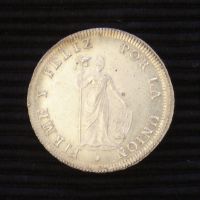
8R 1826 Lima mint, 1st Standing Athene
choice uncirculated
(Don Canaparo, at the 2001 NYI)
|
I think there are 3 main types of the silver Peruvian Standing Athene coins with major varieties within each type.
The 1st, or Small Standing Athene was issued 1826 - 1828 for the Lima mint.
Note that the Standing Athene here has no hair as it is completely covered by her cap.
|
Peru's early coinage depicted the Greek goddess Pallina Athena, patron goddess of wisdom, mathematics, strategy, heroic endeavor,& etc.
|
 8R 1828 Lima mint, 2nd or Classical Standing Athene
8R 1828 Lima mint, 2nd or Classical Standing Athene
uncirculated NGC-62
(Heritage, Jan 13, 2016 NYICS Auction lot# 34768) |
This is the earliest of the 2nd or Classical type.
|
col 3 end 1828 LM
|
 8R 1829 Cuzco mint, 1st Standing Athene frosty uncirculated
8R 1829 Cuzco mint, 1st Standing Athene frosty uncirculated
(James Elmen:
World-Wide Coin Auction, May 2009)
|
Although Lima discontinued the Early or Small Standing Athene in March 1828, replacing it with the
larger Peruvian Standing Athene, Cuzco maintained the design for one more year.
Apparently the Cuzco engraver decided
to embellish the design somewhat by giving the Athene hair which is plainly visable here. This trend of Cuzco & Lima having
different designs continued well into the next type, the 2nd or Classical Athene.
|
This coin is apparently not from the Arequipa hoard as those pieces were obviously cleaned.
This coin is actually quite high grade but would
probably slab only at the 63 level as the planchlet has numerous small flaws which the grading services detract for.
|
 8 R 1833 2nd Standing Athene uncirculated
I bought this at the New York International in 2000
|
The 2nd, or "Classical Standing Athene" appears to be the most common.
Although mintage declined after 1828 (the 1st year of this sub-type) due to boiler explosion at the mint,
it increased after 1830 with 1833 being the peak year [unfortunately].
|
col3 end 1833 |
Republic of Peru - ReUnified
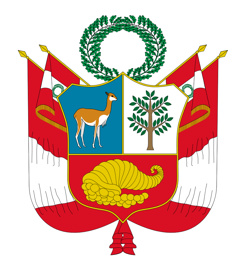 Seal of Peru
Seal of Peru
drawn by Guillermo Romero of Peru, Wikipedia user id: Huhsunqu
|
The country was reunited in 1839.
|

Peru, Arequipa
4 Reals, 1839, NGC-58
Lissner Collection
|
This issuance of Arequipa is extremely well-struck and historical. More will be presently coming
about this subject.
"In 1839,.. 1,965 marks (wt=?) of silver 8 dineros fine were minted"
ibid.
8 dineros = 8/12 = .666 fine, however, this coin appears to be good silver. It appears
that the problem with the moneda feble was not just limited to the issuance of .666 fine coins.
p format, no class.
|
"The city of Arequipa rose in rebellion against the Confederation (The forced
Bolivian-Peruvian Confederation) on 20 Februarey 1839"
Flatt vol4, p 108.
The situation in the South of Peru was extremely unstable at this time.
P format, no class
Find out somehow "What was the Arequipa hoard?"
|

8 Escudos 1840 Standing Liberty
uncirculated (NGC-62)
Goldberg's Millennium Auction, Los Angles, CA; May 26th 2008, lot# 1192
|
A mirror like or proof like finish appears characteristic of all Cuzco gold.
Finally after much waiting I was able to
obtain a nice mint state Athene Standing 8E at a very reasonable price.
The assayer's initial appears on the reverse: an "A"
for Andres Pinto.
Goldberg's Millenium Auction on Peru
span.mikadan-s, cmd to open link in a new window
|
P format, no class
|

8 Reals 1841 Standing Athena
uncirculated (NGC-62)
Lissner collection
|
span.n format, no defintion for display, should be default.
This is the last year of the Classic Style on the 8 Reales & was made in 1840 and 1841.
You will note that, unlike the earlier 8 Reals (Pesos), it now has the finess stated on the reverse.
10 D, 20 Gr = (10 + 20/24) /12 = .902777 or ~ .903.
|
|
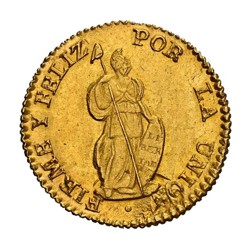
1845 Cuzco mint Gold 1 Escudo
Sedwicks Auction 38, lot 1242, 13-15 Nov 2025
|
1 escudo from the Cuzco mint.
NGC MS-62
|
Cuzco was established as another mint due to the difficulty of transporting raw unminted gold
to Lima. Refer to our map of Peru mints to see.
|
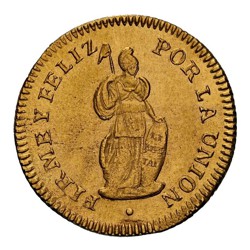
1850 Lima mint Gold 1 Escudo
Sedwicks Auction 38, lot 1243, 13-15 Nov 2025
|
1 escudo from the Lima mint.
Graded NGC: Unc-Details. The obverse is hairlined from an old cleaning. The planchlet
(flan) is not fully struck on the reverse (as made).
|
I used to have another 1850 1 escudo, Lima, but sold it to a Peruvian specialist collector.
Finally I was able to obtain another one but not as nice.
|
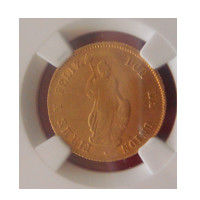
Gold 2 Escudos 1854 pcgs-63 (uncirculated)
(Heritage Long Beach Auction: Sept, 2011)
(ex Eliasberg sale, 2005)
|
Unlike earlier issues (? F.C.),
the 1854 2 escudos is always softly struck as is the case here. Like most of the minor gold this issue was struck at
Lima (M mintmark rev) instead of Cuzco. Cuzco was much more conviently located for shipping gold bullion to which is why the vast
majority of larger gold coins were struck there. That the minors were struck at Lima is indicative that they were produced in small
enough quantities that the difficulty of sending gold there did not matter. This coin has a straight (albeit irregular) reeded edge.
|
This is the third time I attempted to buy this same coin.
The 1st time was when I saw it in person at the Eliasberg (Foreign coin) Auction put on by Stack's/
American Numismatic Rarities (i.e.Bowers & Merena) in 2005. I didn't bid seriously as I was mainly interested in the 8 escudos of Peru
which went for ridiculous sums. The 2nd time was in Spring, 2010 where this coin appeared just after the gold 1850 1 Escudo but I was
unsucessful despite a reasonably stiff bid. The coin reappeared the next year at Heritage's Long Beach sale and was the only lot I succeeded
in getting out of the entire auction! I got it for exactly 75% of my 2010 bid. I guess the previous owner was getting tired of sitting on this
Peruvian gold which frankly nobody else in the world, except for me, is interested in buying.
|
|
This is the last year the Standing Athena design was struck
for the 2 reales and almost the last year of the Standing Athena type (aside from a few patterns).
I am also seeking any silver specimens from the Southern mints of Cuzco, Pasco, and Arequipa.
|
col3 4R-1854
|

4 Reales 1854 choice uncirculated
(Heritage auction: Jan. 2004)
| This is another 2nd, or "Classical" Standing Maiden even
though it was made quite late for the type, e.g. the 1850's. However this one has ornate drapery.
I am also seeking any silver specimens from the Southern mints
(Cuzco, Pasco, Arequipa) to illustrate the diversity further.
|
col3 4R-1854
|
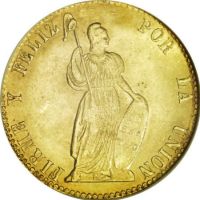
4 Escudos 1855 Lima MB choice uncirculated
(Heritage Signature World Coin auction
Jan. 7th, 2008)
photo cortesy of Heritage Auctions
|
This is a very nice choice uncirculated 4 escudos from the
Limae mint bought at a reasonable price. After I bought it, I discovered that it is the Krause plate coin
as shown on page 473 of the Krause "Spain, Portugal, and the New World" Catalog
The Lima gold, even the 8 escudos, was struck with
a frosty finish, not the P/L finish of Cuzco.
|
For some reason although Cuzco was the primary gold mint, all the 4
escudos, and virtually all of the minor gold (save for a brief issue of 1 escudos), were made at Lima.
I believe this was
the last year the Athene design was issued in gold. |
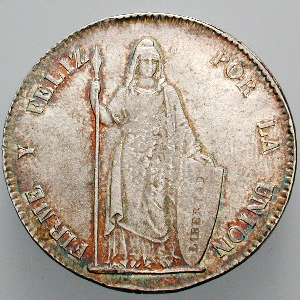
Peso of Castilla 8 Reales, 1846, almost uncirculated
(Harlan J. Berk, 2007) |
This is the 3rd type of Standing Athene silver: the Peso of Castilla.
These coins were named after the treasury minister: Ramon Castilla who later became
a famous President of early Peru
The 1851 8R's appear to be the most common date of these. There was a good sized issuance in 1841 which was exported to
Europe and melted except for one or two? surviving specimens.
|
During the 1840's and 1850's there were a lot of problems in making good metal blanks for minting. Thus many of these pieces
exhibit metal problems and a number have been harshly cleaned over the years. I've seen many 1851's in unacceptable condition but even though this 1846 appears
to have been struck on a poorly prepared metal blank, it was in decent condition and doesn't appear to have been cleaned harshly as most of them were.
It was also reasonably priced: only $75.
I was always very interested in getting a nicer specimen of this type as at this time the 1846 was my only latter
Peru specimen.
|
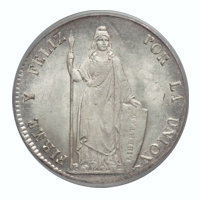
Peso of Castilla 8 Reales, 1847, uncirculated (PCGS-63)
Heritage auction, May 1st, 2012, lot# 27974
photo courtesy of Heritage Auctions |
Even though this specimen is very well preserved you can see that there were still manufacturing problems. In fact the coin surfaces are very
clean and the only reason why it was even graded as low as 63 was [I believe] due to the quality of the strike. Although Krause lists this as a better date,
I've seen a number of other 1847's so I'm not so sure.
Perhaps to compensate for the good deal I got on the 1846, I paid a ridiculously high price for this one. However somebody has to collect the unpopular coins
of Peru...
|
|

Peso of Castilla 8 Reales, 1855, uncirculated (PCGS-62)
Heritage auction,
photo courtesy of Heritage Auctions |
For some reason I can't resist buying these in uncirculated when I see them. This one is semi-P/L.
Even Heritage said it's a rare typein unc in the listing. However being Peru, nobody else bid on it
and I got it for a cheap amount again. |
|
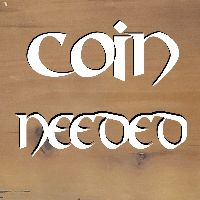
Gold 1/2 Escudo
one is being sought
|
span.n format, no defintion for display, should be default.
This is the last year of the Classic Style on the 8 Reales & was made in 1840 and 1841.
You will note that, unlike the earlier 8 Reals (Pesos), it now has the finess stated on the reverse.
10 D, 20 Gr = (10 + 20/24) /12 = .902777 or ~ .903.
span.c format, display: block
|
span.b format, display: inline-block
span.mikadan-s format, display: inline. Normal except for mikadan font.
|














